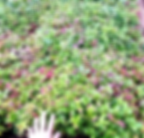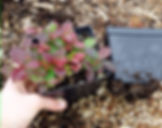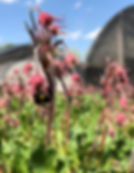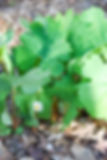
Native Ground Covers
Well adapted to our climate and soils, native plants are increasingly sought after for restoration purposes, more ecologically sensitive selections for properties bordering wild areas, and to create beautiful, low maintenance landscapes.
Sold in 4" (10 cm) pots unless otherwise stated. Most are produced from Ontario seed sources. Some links direct to other pages.
Anemone canadensis (Canada Anemone)
Aquilegia canadensis (Red Columbine)
Arctostaphylos uva-ursi (Bearberry)
Asarum canadense (Canada Wild Ginger)
Cornus canadensis (Bunchberry)
Gaultheria procumbens (Wintergreen)
Geranium maculatum (Wild Geranium)
Geum triflorum (Prairie Smoke)
Native Ferns, 8 species
Sanguinaria canadensis (Bloodroot)
Stylophorum diphyllum (Wood Poppy)
Viola labradorica 'Purpurea' (Labrador Violet)
Companions for Native Ground Covers

Canada Anemone, growing wild on our properties, flowers beautifully in part shade.

Canada Anemone, growing wild on our properties, flowers beautifully in part shade.
Canada Anemone
Anemone canadensis, syn. Anemonastrum canadense
Also called windflower, meadow anemone, roundleaf anemone
Height 12-24 inches (30-60 cm)
Spread 24-48 inches (60-120 cm)
Flower White
Blooming Late spring - early summer
Light Sun to shade
Moisture Moist to average, tolerates drought once established
Soil Adaptable, tolerates heavy clay soils
Current observed range in North America (iNaturalist.ca)
This low maintenance native ground cover literally appeared on our doorstep. When we removed a dying American Elm near our potting shed, this plant sprung to life around the stump. We have come to appreciate its tenacity as a massing perennial for naturalized landscapes and bank edges; even within shady concrete beds in an urban landscape by itself or with grasses. It spreads vigorously by rhizomes to fill an area, and respectfully should not be mixed with more timid perennials.
Recommendations for growing Canada Anemone
Canada anemone grows best in moist meadows, ravines and partially shaded woodland edges. Its colonizing tendency can be curtailed somewhat in darker shade, drier clay soils and root-barrier contained beds. Great for naturalizing, massing or mixing with other native meadow species or grasses. Provides habitat for pollinators; deer-resistant. Generally free from pests and disease, and can tolerate repeated mulching and salt spray. Water well during first year of establishment.


A robust seed production bed of mixed genetic sources for growing our 4" pots.

Red Columbine
Aquilegia canadensis
Also called wild columbine, Canadian columbine
Height 18-24 inches (45-60 cm)
Spread Individual clumps 12-18 inches (30-45 cm), readily self-seeds
Flower Red and yellow
Blooming Late spring, sporadically throughout summer
Light Full sun to partial shade best for flowering
Moisture Average to dry
Soil Well-drained, alkaline or acidic
Current observed range in North America (iNaturalist.ca)
Better description coming soon!


Taken near Bancroft, Ontario


Bearberry
Arctostaphylos uva-ursi
Also called kinnikinnick, bear grape, uva-ursi
Height 6-8 inches (15-20 cm)
Spread 24-36 inches (60-90 cm)
Flower White
Blooming Late spring
Light Full sun to light shade
Moisture Average to dry
Soil Well-drained, acidic
Current observed range in North America (iNaturalist.ca)
An excellent broadleaf evergreen woody subshurb for informal medium to large scale landscape areas of rugged landscapes. Very hardy and drought tolerant once established. Well-suited to Ontario's cottage country where it can be found naturally, it thrives on rocky barrens, exposed gravelly slopes and amongst boulders in full sun or under light shade. Ornamental features include shiny cupped leaves, red fall colour, profusions of white flowers and red berries in fall. Slow to moderate growth rate.
Recommendations for growing Bearberry
Bearberry grows best on well-drained, sandy, gritty or gravelly soils, neutral to acidic, with minimal fertility. The biggest challenges to establishing bearberry is over-mulching, over-watering and over-fertilizing. Does not like high humidity, alkaline clay or compacted soils. Exposure and air circulation reduces humidity and limits any crown rot or leaf blotches. Otherwise free from pests and disease, and can tolerate salt spray. Maintenance of established patches may include mowing or trimming after bloom to keep patch thick and tidy.


Ready to ship!


Bunchberry
Cornus canadensis, syn. Chamaepericlymenum canadense
Also called dwarf cornel, creeping dogwood, crackerberry, quartre-temps
Height 4-8 inches (10-20 cm)
Spread 12-24 inches (30-60 cm)
Flower White
Blooming Spring to summer
Light Part shade to full shade
Moisture Moist
Soil Humus-rich, neutral to acidic
Current observed range in North America (iNaturalist.ca)
A widespread species in Canada and the United States, from cool, moist woodlands to mountain ranges and sphagnum bogs. This mat-forming stoloniferous species is deciduous, sending up distinctive dogwood leaves in spring, followed by white flowers (actually showy bracts) late spring to summer. If pollinated, clusters of vibrant red berries form against a beautiful backdrop of bronze-red fall colour. Ideal in smaller plantings under conifers, in combination with other native woodland species, rhododendrons, azaleas or ferns.
Recommendations for growing Bunchberry
Native woodland soils and conifer duff is a good medium for bunchberry. If garden soil is light-textured or gravelly, blend in compost and peat moss for moisture retention. Plant at soil surface and mulch thinly (1-2"); conifer needles make great mulch for this plant. Direct afternoon sun and wind exposure can burn leaves. Serious diseases are seldom encountered, occasionally suffers root rot and leaf spots in wet years. No ongoing maintenance needs required except watering during hot spells.

Newly expanding foliage is vibrant.


Vibrant red berries add fall interest and wildlife food.

Newly expanding foliage is vibrant.
Wintergreen
Gaultheria procumbens
Also called winterberry, checkerberry, eastern teaberry
Height 4-6 inches (10-15 cm)
Spread 12 inches (30 cm)
Flower White, sometimes tinged with pink
Blooming Spring
Light Part shade to full shade
Moisture Average to moist
Soil Humus-rich, favouring acidic soils
Current observed range in North America (iNaturalist.ca)
One of the most widespread, durable and pleasing native ground covers with outstanding ornamental characteristics. Thick, shiny evergreen foliage was once used to distill oil of wintergreen, and comes out in a multi-coloured spring flush. Small pinkish-white flowers are not always noticed but the large red berries are, and are sometimes offered as potted Christmas plants. Spreads slowly by underground stolons, and said to attract grouse and partridge to the garden. Combine with other acidophiles in the woodland garden for best effect. Will tolerate periodic drought.
Recommendations for growing Wintergreen
Native woodland soils and pine duff is a good medium for wintergreen. Blend in peat moss and compost to light or alkaline soils and cultivate before planting. Plant at soil surface and mulch thinly (1-2"); conifer needles make great mulch for this plant. Direct afternoon sun and wind exposure can burn leaves. Serious diseases are seldom encountered, occasionally suffers root rot in wet years. No ongoing maintenance needs required except watering during hot spells.



Prairie Smoke
Geum triflorum
Also called three-flowers avens, old man's whiskers
Height 8-12 inches (20-30 cm)
Spread 12-18 inches (30-45 cm), may self-seed
Flower Pink and white, seed head a pink upright tuft
Blooming Spring to early summer
Light Full sun to light shade
Moisture Moist to dry
Soil Well drained to average, tolerates shallow soils and rock crevices
Current observed range in North America (iNaturalist.ca)
Excellent for use in the rock garden or sunny perennial border. Better description coming soon!




Bloodroot
Sanguinaria canadaensis
Also called Canada puccoon, bloodwort, redroot, red puccoon
Height 10-20 inches (20-50 cm)
Spread 12-18 inches (30-45 cm), ants disperse seeds in vicinity
Flower White (rarely pink) with large yellow stamens
Blooming Early spring
Light Part shade to full shade, best under mature trees
Moisture Average to consistently damp
Soil Adaptable, rich to well-drained floodplain meadows
Current observed range in North America (iNaturalist.ca)
A unique woodland plant of the deciduous North American forest and one of the earliest harbringers of spring. Single flowers are borne on stalks that emerge cupped by a single leaf. Flowers open on sunny days and close at night if not pollinated, lasting usually 5-7 days each. Mining bees are the most effective pollinators, but flowers also visited by bee flies, carpenter bees and cuckoo bees. Sand-dollar-esque leaves unfurl to protect developing upright seed pods. When ripe, ants carry the red seeds away, a process called myrmechochory. Plants excude sap if leaves or roots are broken, which can cause skin irritation or scarring in some people.
Recommendations for growing Bloodroot
Though this plant is a total show-stopped in flower, the best time to transplant bloodroot is August-September, when it is transferring the energy from the spent leaves into the root system. Dividing the root system can cause rhizomes to rot easily, so it is best to move smaller seedling plants intact. If kept too damp or mulched too heavily, leaf stems can rot at the base and fall over. Provide ample air circulation in the garden by ensuring thick-leaved plants don't smother the clumps. Best tucked into sloped gardens with pockets of rich organic matter.


Pluck these off if you don't want too many extra seedlings in the garden!


Wood Poppy
Stylophorum diphyllum
Also called celandine poppy
Height 12-24 inches (30-60 cm)
Spread 18-24 inches (45-60 cm), ants disperse seeds in vicinity
Flower White (rarely pink) with large yellow stamens
Blooming Early spring
Light Part shade to full shade, best under mature trees
Moisture Average to consistently damp
Soil Rich, limestone based soils, floodplains
Current observed range in North America (iNaturalist.ca)
This stunning woodland plant deserves as much attention as hostas, with handsome blue-green pinnately lobed leaves. Wood poppy is generally maintenance-free, can fill large areas amongst other shady shrubs and under mature trees, and The large 2-3" sunny yellow flowers light up like fireworks in the spring garden. It can be confused with the non-native/invasive greater celandine (Chelidonium majus), whose seed pods are skinny and upright. Our seed source originally came from gardens in Niagara Falls, but it has proven to be very adaptable to the Peterborough region, and travels all over the nursery via ants. It dislikes full sun and direct midsummer sun.
Recommendations for growing Wood Poppy
In spite of its conservation challenges in Canada (wild populations are protected in Ontario), this plant can be a bit of bully with other more mild-mannered woodland plants, even so far as smothering very small-statured trilliums and trout lilies. If you do not want it to seed, sheer off foliage with hedge trimmers shortly after flowering. Root systems are robust and can be easily divided late summer to early fall. The plant excudes a yellow sap that can stain hands, tools and clothing.



Individual clumps will spread and seedlings pop up close by.

Labrador Violet
Viola labradorica 'Purpurea'
Also known as alpine violet, American dog violet
Height 4-6 inches (10-15 cm)
Spread 8-12" inches (20-30 cm), and by seed
Flower Purple
Blooming Spring to fall
Light Sun to shade
Moisture Average to dry
Soil Adaptable
Current observed range in North America (iNaturalist.ca)
Although the name suggests otherwise, this species is widespread in Canada and the US, from the East Coast to Alaska, and native to Greenland. Allan Armitage calls this "one of the best garden violets in the entire genus". This hardy and ornamental selection is notable for its attractive rich purple, heart-shaped leaves, welcome early spring flush of purple flowers, and adaptable nature to a variety of sites. Clumps spread outward by short stolons and also by an abundance of seeds. Well suited to naturalized landscapes, rock gardens, cracks and crevices of slopes, and worthy of attention for interplanting with smaller ground covers, ferns and beneath large trees. A much better choice than Viola odorata. Flowers and leaves are edible.
Recommendations for growing Labrador Violet
Of all the native plants in our catalogue, this is probably the easiest to grow. Performs its best with average moisture, average fertility and part shade, but seedlings will find their way to the most appropriate places. Foliage colour bleaches out in full sun. Low tolerance for extended periods of drought. Plant at soil surface and mulch with composted pine bark fines. If you do not wish to have so many seedlings, shear spent flowers. Small seedlings are easy to weed or transplant if desired.
Companions for Native Ground Covers
With the variety of adaptations and possible landscape uses, contact us for appropriate companions to suit your project.
